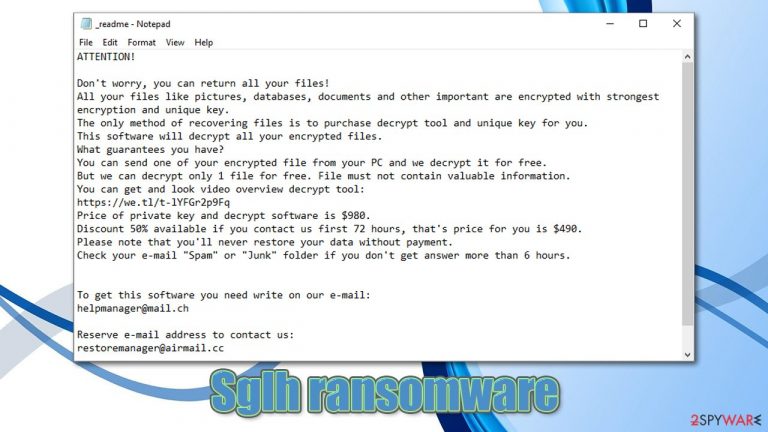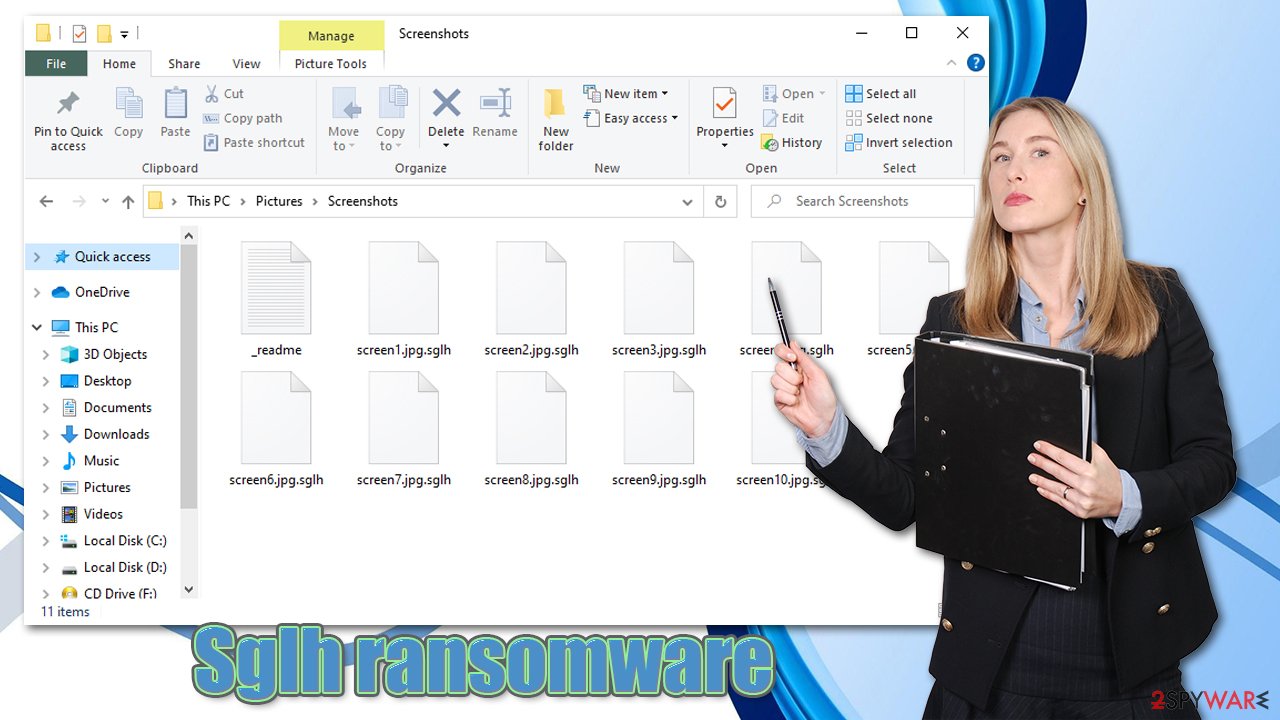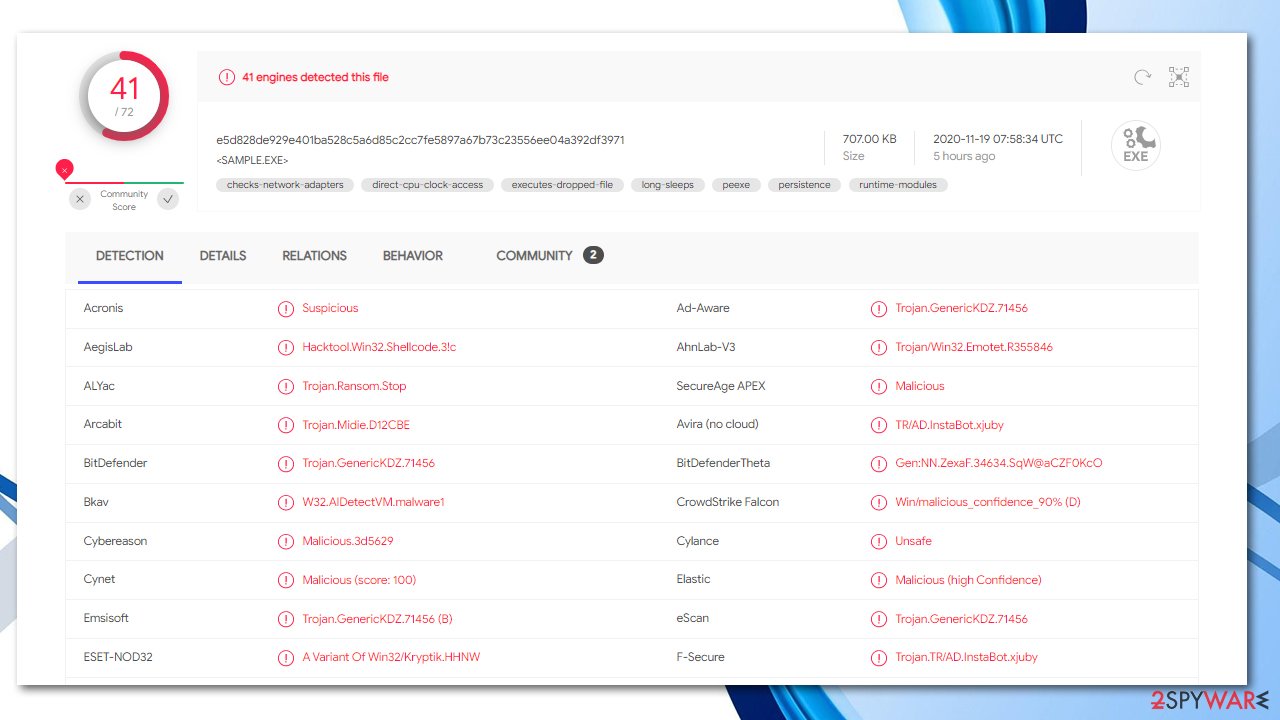Sglh ransomware (virus) - Decryption Methods Included
Sglh virus Removal Guide
What is Sglh ransomware?
Sglh ransomware is the threat that asks for the payment in exchange for the alleged decryption tool

Sglh ransomware is a cryptovirus that encrypts all non-system files on the victim's machine and then demands a ransom to unlock them. All personal files, such as documents, archives, databases, pics, and so on, are locked and appended with a .sglh extension. Like its whole family of Djvu ransomware, as soon as malware is done with encryption, a ransom note, titled _readme.txt, is created in all compromised folders. All encryption is done using a military-grade RSA[1] algorithm.
Within the ransom note, developers of the Sglh virus explain to the victims that all of their essential data is locked and only they have the power to unlock it, i.e., have the necessary decryption tool. The cybercriminals offer to send them one file via the helpmanager@mail.ch or restoremanager@airmail.cc emails for free decryption, thus proving that they really do have the required decryption tool/key. Furthermore, a link is given to a video where the victims can witness the said tool in action. In a nutshell, the criminals are trying very hard to convince their victims that they will definitely send the required software after meeting their demands.
| name | Sglh ransomware |
|---|---|
| type | Ransomware, cryptovirus |
| Family | Djvu/STOP |
| Appended file extension | All non-system files are appended with .sglh extension |
| Ransom note | _readme.txt |
| Ransom amount | If the victims act quickly and contact the criminals within 72 hours of encryption, the price would be $480. Otherwise, the amount is $960 |
| Criminal contact details | helpmanager@mail.ch, restoremanager@airmail.cc |
| Data recovery | Emsisoft Decryptor for STOP/Djvu could be useful for some victims; otherwise, the only guaranteed way to recover files is by using backups |
| Virus removal | Elimination of ransomware should be entrusted to professional anti-malware software |
| System tune-up | System files and settings might have been changed for the virus to complete its mission, to undo all altercations use the powerful FortectIntego tool |
The decryption tool's price and terms are the same as with its previous versions (Agho, Jdyi, Epor, etc.) – $490 if the victims contact the perpetrators within 72 hours of the infection. If not, the price is doubled to $980.
Although it is not mentioned in the ransom note, we can safely speculate that the preferred payment method will be in cryptocurrency Bitcoins. Sglh virus is identical to other threats in the same family. Two emails (helpmanager@mail.ch, restoremanager@airmail.cc) are provided to establish contact with the criminals by sending them the victim's unique appointed ID along with one encrypted file.
Meeting the demands of criminals isn't the best idea because victims could get scammed. Search for alternative methods to restore the encrypted data, for example – from your backups. It's a tough choice, but every owner of an infected device has to make it.
We, along with other experts,[2] advise deleting the malware from the device. The longer it stays in the computer system, the more damage it could do (for example, Djvu versions are known to inject data-stealing modules into Google Chrome or another web browser and harvest login credentials or other sensitive information), so use SpyHunter 5Combo Cleaner or Malwarebytes to remove Sglh ransomware automatically.
These apps might protect from such misfortunes in the future if kept up to date. Detection[3] names and the whole procedure of eliminating the virus can get affected by the threat itself when it manages to change particular settings or disable programs. So you may benefit from Safe Mode.

Sending your money shouldn't be an option
The payment that virus creators ask from victims can be convincing. Especially when some of these actors try to scare people into paying or promises discounts for the first 72 hours like this malware family. However, since this is a well-known family, you shouldn't think about transferring money because malicious actors do not care for your files and this is not the way to fight ransomware at all.
When Sglh ransomware removal is completed, you're not out of the woods yet. You have to check your system files and settings for any irregularities that might cause your device to exhibit abnormal behavior, such as crashing, severe lag, etc. The FortectIntego tool will locate and fix any damage the virus might have to the system settings/files.
Message from the developers of the ransomware to the victims (from _readme.txt file) reads:
ATTENTION!
Don't worry, you can return all your files!
All your files like pictures, databases, documents and other important are encrypted with strongest encryption and unique key.
The only method of recovering files is to purchase decrypt tool and unique key for you.
This software will decrypt all your encrypted files.
What guarantees you have?
You can send one of your encrypted file from your PC and we decrypt it for free.
But we can decrypt only 1 file for free. File must not contain valuable information.
You can get and look video overview decrypt tool:
https://we.tl/t-lYFGr2p9Fq
Price of private key and decrypt software is $980.
Discount 50% available if you contact us first 72 hours, that's price for you is $490.
Please note that you'll never restore your data without payment.
Check your e-mail “Spam” or “Junk” folder if you don't get answer more than 6 hours.To get this software you need write on our e-mail:
helpmanager@mail.chReserve e-mail address to contact us:
restoremanager@airmail.ccYour personal ID:
The option for decrypting .sglh files
It is a known fact within the tech-savvy community that Djvu family ransomware, along with the file virus, is spread out using illegal activation kits (popularly knows as cracks)[4] either for software or games. These infected toolkits are distributed via file-sharing platforms like the torrent site The Pirate Bay and others.
Immediately after a soon-to-be victim downloads a crack, for let's said, Adobe Photoshop Essentials, a payload file of Sglh ransomware executes itself, initiating the encryption. People should stay away from these sites and support their beloved software developers by purchasing their products directly from them or official distributors.

Now about the file recovery. If you had backups – no worries, just remove the virus, check system health with a proper tune-up tool, and retrieve .sglh files easily. If you didn't, please export all appended files to an offline storage device – such as a USB drive, and wait for the decryption tool to be created.
Researchers are working constantly for this cause, so be patient, and check back with us from time to time, as we update our readers with all the latest news. If you're very impatient, check out recovery options for experienced computer users at the bottom of this article, they might be helpful.
Instructions of the proper Sglh ransomware virus removal
From pesky adware to the atrocious trojan horses, any kind of malware must be eliminated swiftly before any more harm is done to an already infected device. We recommend using time-proven anti-malware software like SpyHunter 5Combo Cleaner and Malwarebytes to remove Sglh ransomware from contaminated devices automatically and prevent such instances in the future.
Djvu family viruses are known to alter system files and settings, preventing victims from opening any security sites, using anti-malware software, and so on. Sglh ransomware removal won't magically restore your files to their pre-encryption phase. To restore your device back to normal, you have to use a system tune-up tool like the FortectIntego.
Getting rid of Sglh virus. Follow these steps
Manual removal using Safe Mode
Malware can prevent from deleting itself when Windows are run in normal mode. Try doing that when using Safe Mode with Networking:
Important! →
Manual removal guide might be too complicated for regular computer users. It requires advanced IT knowledge to be performed correctly (if vital system files are removed or damaged, it might result in full Windows compromise), and it also might take hours to complete. Therefore, we highly advise using the automatic method provided above instead.
Step 1. Access Safe Mode with Networking
Manual malware removal should be best performed in the Safe Mode environment.
Windows 7 / Vista / XP
- Click Start > Shutdown > Restart > OK.
- When your computer becomes active, start pressing F8 button (if that does not work, try F2, F12, Del, etc. – it all depends on your motherboard model) multiple times until you see the Advanced Boot Options window.
- Select Safe Mode with Networking from the list.

Windows 10 / Windows 8
- Right-click on Start button and select Settings.

- Scroll down to pick Update & Security.

- On the left side of the window, pick Recovery.
- Now scroll down to find Advanced Startup section.
- Click Restart now.

- Select Troubleshoot.

- Go to Advanced options.

- Select Startup Settings.

- Press Restart.
- Now press 5 or click 5) Enable Safe Mode with Networking.

Step 2. Shut down suspicious processes
Windows Task Manager is a useful tool that shows all the processes running in the background. If malware is running a process, you need to shut it down:
- Press Ctrl + Shift + Esc on your keyboard to open Windows Task Manager.
- Click on More details.

- Scroll down to Background processes section, and look for anything suspicious.
- Right-click and select Open file location.

- Go back to the process, right-click and pick End Task.

- Delete the contents of the malicious folder.
Step 3. Check program Startup
- Press Ctrl + Shift + Esc on your keyboard to open Windows Task Manager.
- Go to Startup tab.
- Right-click on the suspicious program and pick Disable.

Step 4. Delete virus files
Malware-related files can be found in various places within your computer. Here are instructions that could help you find them:
- Type in Disk Cleanup in Windows search and press Enter.

- Select the drive you want to clean (C: is your main drive by default and is likely to be the one that has malicious files in).
- Scroll through the Files to delete list and select the following:
Temporary Internet Files
Downloads
Recycle Bin
Temporary files - Pick Clean up system files.

- You can also look for other malicious files hidden in the following folders (type these entries in Windows Search and press Enter):
%AppData%
%LocalAppData%
%ProgramData%
%WinDir%
After you are finished, reboot the PC in normal mode.
Remove Sglh using System Restore
System Restore is another useful option that might help:
-
Step 1: Reboot your computer to Safe Mode with Command Prompt
Windows 7 / Vista / XP- Click Start → Shutdown → Restart → OK.
- When your computer becomes active, start pressing F8 multiple times until you see the Advanced Boot Options window.
-
Select Command Prompt from the list

Windows 10 / Windows 8- Press the Power button at the Windows login screen. Now press and hold Shift, which is on your keyboard, and click Restart..
- Now select Troubleshoot → Advanced options → Startup Settings and finally press Restart.
-
Once your computer becomes active, select Enable Safe Mode with Command Prompt in Startup Settings window.

-
Step 2: Restore your system files and settings
-
Once the Command Prompt window shows up, enter cd restore and click Enter.

-
Now type rstrui.exe and press Enter again..

-
When a new window shows up, click Next and select your restore point that is prior the infiltration of Sglh. After doing that, click Next.


-
Now click Yes to start system restore.

-
Once the Command Prompt window shows up, enter cd restore and click Enter.
Bonus: Recover your data
Guide which is presented above is supposed to help you remove Sglh from your computer. To recover your encrypted files, we recommend using a detailed guide prepared by 2-spyware.com security experts.If your files are encrypted by Sglh, you can use several methods to restore them:
Try to recover files using the Data Recovery Pro
- Download Data Recovery Pro;
- Follow the steps of Data Recovery Setup and install the program on your computer;
- Launch it and scan your computer for files encrypted by Sglh ransomware;
- Restore them.
Try using another useful Windows OS tool – Windows Previous Version
Using this feature users might be able to retrieve file one by one.
- Find an encrypted file you need to restore and right-click on it;
- Select “Properties” and go to “Previous versions” tab;
- Here, check each of available copies of the file in “Folder versions”. You should select the version you want to recover and click “Restore”.
If Shadow Copies are intact Shadow Explorer will help
If the ransomware didn't remove these copies from your disc, then Shadow Explorer might restore them.
- Download Shadow Explorer (http://shadowexplorer.com/);
- Follow a Shadow Explorer Setup Wizard and install this application on your computer;
- Launch the program and go through the drop down menu on the top left corner to select the disk of your encrypted data. Check what folders are there;
- Right-click on the folder you want to restore and select “Export”. You can also select where you want it to be stored.
Possible decryption tool for the ransomware
There is a company called Emisoft that focuses on Djvu family ransomware decryption tools. Since this file virus is brand new, the decoder might not work, but there's always hope that the software company will soon add a decryption key for this virus too. Download the toolkit and try it out at your own risk.
Finally, you should always think about the protection of crypto-ransomwares. In order to protect your computer from Sglh and other ransomwares, use a reputable anti-spyware, such as FortectIntego, SpyHunter 5Combo Cleaner or Malwarebytes
How to prevent from getting ransomware
Protect your privacy – employ a VPN
There are several ways how to make your online time more private – you can access an incognito tab. However, there is no secret that even in this mode, you are tracked for advertising purposes. There is a way to add an extra layer of protection and create a completely anonymous web browsing practice with the help of Private Internet Access VPN. This software reroutes traffic through different servers, thus leaving your IP address and geolocation in disguise. Besides, it is based on a strict no-log policy, meaning that no data will be recorded, leaked, and available for both first and third parties. The combination of a secure web browser and Private Internet Access VPN will let you browse the Internet without a feeling of being spied or targeted by criminals.
No backups? No problem. Use a data recovery tool
If you wonder how data loss can occur, you should not look any further for answers – human errors, malware attacks, hardware failures, power cuts, natural disasters, or even simple negligence. In some cases, lost files are extremely important, and many straight out panic when such an unfortunate course of events happen. Due to this, you should always ensure that you prepare proper data backups on a regular basis.
If you were caught by surprise and did not have any backups to restore your files from, not everything is lost. Data Recovery Pro is one of the leading file recovery solutions you can find on the market – it is likely to restore even lost emails or data located on an external device.
- ^ RSA Encryption. Briliant. Learn to think.
- ^ Novirus. Novirus. Spyware and security news.
- ^ Detection rate. VirusTotal. Online malware scanner.
- ^ What Are Cracked Software And Why You Shouldn’t Use Them. Provarex. Cyber security services, training and talks.







